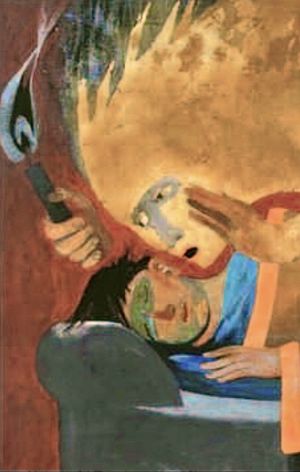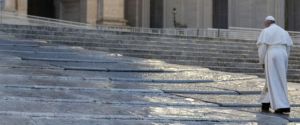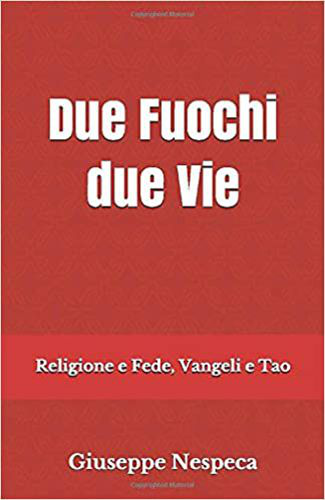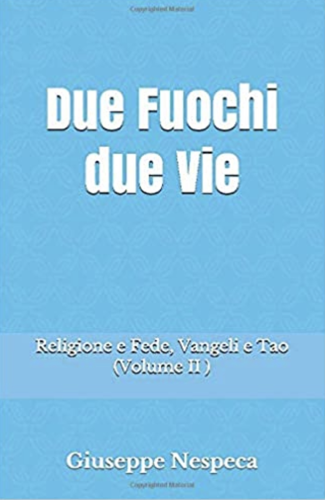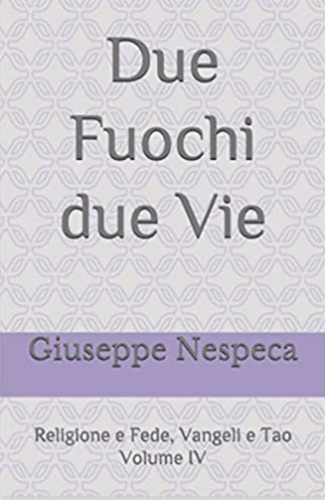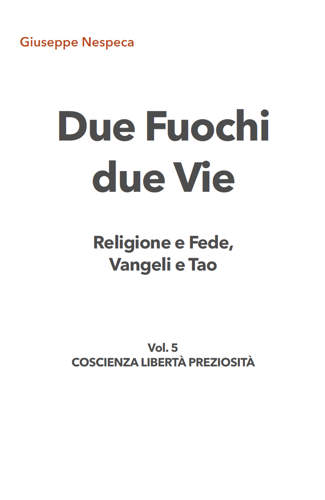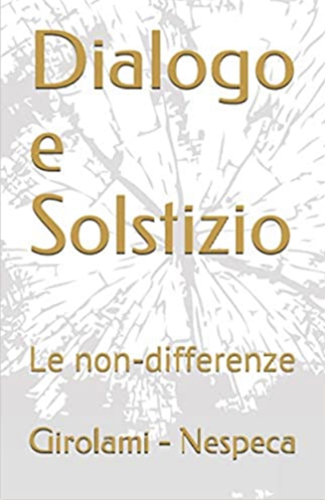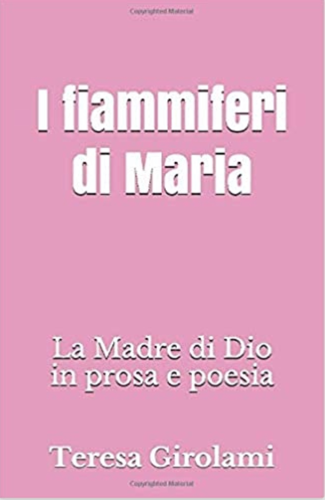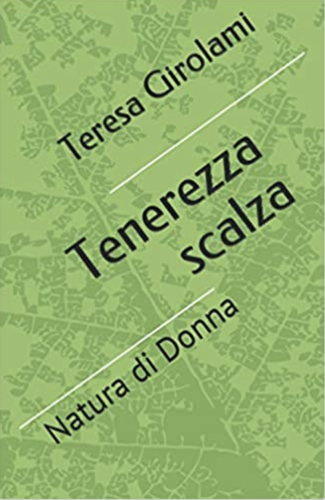
don Giuseppe Nespeca
Giuseppe Nespeca è architetto e sacerdote. Cultore della Sacra scrittura è autore della raccolta "Due Fuochi due Vie - Religione e Fede, Vangeli e Tao"; coautore del libro "Dialogo e Solstizio".
Solo voice and spiritual poetic movement
Canticle of the Blessed Virgin
1. We have now arrived at the final destination of the long journey begun exactly five years ago in Spring 2001, by my beloved Predecessor, the unforgettable Pope John Paul II. In his Catecheses, the great Pope wanted to cover the whole sequence of the Psalms and Canticles that constitute the fundamental prayerful fabric of the Liturgy of Lauds and Vespers. Having now reached the end of this pilgrimage through the texts, similar to a stroll in a garden filled with flowers of praise, invocation, prayer and contemplation, let us now make room for that Canticle which seals in spirit every celebration of Vespers: the Magnificat (Lk 1: 46-55).
It is a canticle that reveals in filigree the spirituality of the biblical anawim, that is, of those faithful who not only recognize themselves as "poor" in the detachment from all idolatry of riches and power, but also in the profound humility of a heart emptied of the temptation to pride and open to the bursting in of the divine saving grace. Indeed, the whole Magnificat, which we have just heard the Sistine Chapel Choir sing, is marked by this "humility", in Greek tapeinosis, which indicates a situation of material humility and poverty.
2. The first part of the Marian canticle (cf. Lk 1: 46-50) is a sort of solo voice that rises to Heaven to reach the Lord. The constant resonance of the first person should be noted: "My soul... my spirit... my Saviour... has done great things for me... [they] will call me blessed...". So it is that the soul of the prayer is the celebration of the divine grace which has burst into the heart and life of Mary, making her Mother of the Lord. We hear the Virgin's own voice speaking of her Saviour who has done great things in her soul and body.
The intimate structure of her prayerful canticle, therefore, is praise, thanksgiving and grateful joy. But this personal witness is neither solitary nor intimistic, purely individualistic, because the Virgin Mother is aware that she has a mission to fulfil for humanity and her experience fits into the history of salvation.
She can thus say: "And his mercy is on those who fear him from generation to generation" (v. 50). With this praise of the Lord, Our Lady gives a voice to all redeemed creatures, who find in her "fiat", and thus in the figure of Jesus, born of the Virgin, the mercy of God.
3. It is at this point that the second poetic and spiritual part of the Magnificat unfolds (cf. vv. 51-55). It has a more choral tone, almost as if the voices of the whole community of the faithful were associated with Mary's voice, celebrating God's amazing decision.
In the original Greek of Luke's Gospel, we have seven aorist verbs that indicate the same number of actions which the Lord carries out repeatedly in history: "He has shown strength... he has scattered the proud... he has put down the mighty... he has exalted those of low degree... he has filled the hungry with good things... the rich he has sent empty away... he has helped... Israel".
In these seven divine acts, the "style" that inspires the behaviour of the Lord of history stands out: he takes the part of the lowly. His plan is one that is often hidden beneath the opaque context of human events that see "the proud, the mighty and the rich" triumph.
Yet his secret strength is destined in the end to be revealed, to show who God's true favourites are: "Those who fear him", faithful to his words: "those of low degree", "the hungry", "his servant Israel"; in other words, the community of the People of God who, like Mary, consist of people who are "poor", pure and simple of heart. It is that "little flock" which is told not to fear, for the Lord has been pleased to give it his Kingdom (cf. Lk 12: 32). And this Canticle invites us to join the tiny flock and the true members of the People of God in purity and simplicity of heart, in God's love.
4. Let us therefore accept the invitation that St Ambrose, the great Doctor of the Church, addresses to us in his commentary on the text of the Magnificat: "May Mary's soul be in each one to magnify the Lord, may Mary's spirit be in each one to rejoice in God; if, according to the flesh, the Mother of Christ is one alone, according to the faith all souls bring forth Christ; each, in fact, welcomes the Word of God within.... Mary's soul magnifies the Lord and her spirit rejoices in God because, consecrated in soul and spirit to the Father and to the Son, she adores with devout affection one God, from whom come all things and only one Lord, by virtue of whom all things exist" (Exposition of the Holy Gospel according to Saint Luke, 2: 26-27: SAEMO, XI, Milan-Rome, 1978, p. 169).
In this marvellous commentary on the Magnificat by St Ambrose, I am always especially moved by the surprising words: "If, according to the flesh the Mother of Christ is one alone, according to the faith all souls bring forth Christ: indeed, each one intimately welcomes the Word of God". Thus, interpreting Our Lady's very words, the Holy Doctor invites us to ensure that the Lord can find a dwelling place in our own souls and lives. Not only must we carry him in our hearts, but we must bring him to the world, so that we too can bring forth Christ for our epoch. Let us pray the Lord to help us praise him with Mary's spirit and soul, and to bring Christ back to our world.
[Pope Benedict, General Audience 15 February 2006]
Magnificat: response to the Annunciation, albeit without influence in history
1. Inspired by the Old Testament tradition, with the canticle of the Magnificat Mary celebrates the wonders wrought in her by God. The canticle is the Virgin's response to the mystery of the Annunciation: the angel had invited her to rejoice, now Mary expresses the exultation of her spirit in God the Saviour. Her joy stems from her personal experience of God's benevolent gaze upon her, a poor and uninfluenced creature in history.
With the expression Magnificat, a Latin version of a Greek word of the same meaning, the greatness of God is celebrated, who with the angel's announcement reveals his omnipotence, exceeding the expectations and hopes of the people of the Covenant and even the noblest desires of the human soul.
Before the Lord, powerful and merciful, Mary expresses the feeling of her own littleness: "My soul magnifies the Lord, and my spirit exults in God, my Saviour, because he has looked upon the humility of his handmaid" (Lk 1:47-48). The Greek term 'tapéinosis' is probably borrowed from the canticle of Anna, mother of Samuel. It indicates the "humiliation" and "misery" of a barren woman (cf. 1 Sam 1:11), who entrusts her sorrow to the Lord. With such an expression, Mary makes known her situation of poverty and her awareness of being small before God who, with a gratuitous decision, laid his gaze on her, a humble girl from Nazareth, calling her to become the Mother of the Messiah.
2. The words "henceforth all generations shall call me blessed" (Lk 1:48) start from the fact that Elizabeth first proclaimed Mary "blessed" (Lk 1:45). Not without audacity, the canticle predicts that the same proclamation will extend and expand with unstoppable dynamism. At the same time, it testifies to the special veneration for the Mother of Jesus, present in the Christian community since the first century. The Magnificat constitutes the first fruits of the various expressions of worship, transmitted from one generation to the next, with which the Church manifests its love for the Virgin of Nazareth.
3. "Great things have the Almighty done in me, and holy is his name: from generation to generation his mercy is poured out on those who fear him" (Lk 1:49-50).
What are the "great things" wrought in Mary by the Almighty? The expression recurs in the Old Testament to indicate the deliverance of the people of Israel from Egypt or Babylon. In the Magnificat, it refers to the mysterious event of Jesus' virginal conception, which took place in Nazareth after the angel's announcement.
In the Magnificat, a truly theological canticle because it reveals Mary's experience of God's face, God is not only the Almighty to whom nothing is impossible, as Gabriel had declared (cf. Lk 1:37), but also the Merciful One, capable of tenderness and faithfulness towards every human being.
4. "He has unfolded the power of his arm, he has scattered the proud in the thoughts of their hearts; he has overthrown the mighty from their thrones, he has lifted up the lowly; he has filled the hungry with good things, he has sent the rich empty-handed" (Lk 1:51-53).
With her sapiential reading of history, Mary introduces us to discover the criteria of God's mysterious action. He, reversing the world's judgements, comes to the rescue of the poor and the little ones, to the detriment of the rich and the powerful and, in a surprising way, fills the humble with goods, who entrust their existence to him (cf. John Paul II, Redemptoris Mater, 37).
These words of the canticle, while showing us in Mary a concrete and sublime model, make us realise that it is above all humility of heart that attracts God's benevolence.
5. Finally, the canticle extols the fulfilment of the promises and God's faithfulness to the chosen people: 'He has come to the rescue of Israel, his servant, remembering his mercy, as he promised our fathers, for Abraham and his descendants, for ever' (Lk 1:54-55).
Filled with divine gifts, Mary does not stop her gaze at her personal case, but understands how these gifts are a manifestation of God's mercy for all his people. In her, God fulfils his promises with superabundant faithfulness and generosity.
Inspired by the Old Testament and the spirituality of the daughter of Zion, the Magnificat surpasses the prophetic texts at its origin, revealing in the 'full of grace' the beginning of a divine intervention that goes far beyond Israel's messianic hopes: the holy mystery of the Incarnation of the Word.
[Pope John Paul II, General Audience 6 November 1996]
Joy, not by the absence of problems. We are her weakness of love
What does our Mother advise us? Today in the Gospel the first thing she says is: “My soul magnifies the Lord” (Lk 1:46). Accustomed to hearing these words, perhaps we no longer pay attention to their meaning. To “magnify” literally means “to make great”, to enlarge. Mary “aggrandises the Lord”: not problems, which she did not lack at the time, but the Lord. How often, instead, we let ourselves be overwhelmed by difficulties and absorbed by fears! Our Lady does not, because she puts God as the first greatness of life. From here the Magnificat springs forth, from here joy is born: not from the absence of problems, which come sooner or later, but joy is born from the presence of God who helps us, who is near us. Because God is great. And, above all, God looks on the lowly ones. We are His weakness of love: God looks on and loves the lowly.
Mary, in fact, acknowledges that she is small and exalts the “great things” (v. 49) the Lord has done for her. What are they? First and foremost, the unexpected gift of life: Mary is a virgin yet she becomes pregnant; and Elizabeth, too, who was elderly, is expecting a child. The Lord works wonders with those who are lowly, with those who do not believe that they are great but who give ample space to God in their life. He enlarges His mercy to those who trust in Him, and raises up the humble. Mary praises God for this.
And we - we might ask ourselves - do we remember to praise God? Do we thank Him for the great things He does for us? For every day that He gives us, because He always loves us and forgives us, for His tenderness? In addition, for having given us His Mother, for the brothers and sisters He puts on our path, and because He opened Heaven to us? Do we thank God, praise God for these things? If we forget the good, our hearts shrink. But if, like Mary, we remember the great things that the Lord does, if at least once a day we were to “magnify” Him, then we would take a great step forward. One time during the day to say: “I praise the Lord”, to say, “Blessed be the Lord”, which is a short prayer of praise. This is praising God. With this short prayer, our hearts will expand, joy will increase. Let us ask Our Lady, the Gate of Heaven, for the grace to begin each day by raising our eyes to Heaven, toward God, to say to Him: "Thank you!” as the lowly ones say to the great ones. “Thank you”.
[Pope Francis, Angelus 15 August 2020]
Christmas: Easter. Breath for me
Annunciation to Joseph: meaning and value of Doubt
(Mt 1:18-24)
«Even through Joseph’s fears, God’s will, his history and his plan were at work. Joseph, then, teaches us that faith in God includes believing that he can work even through our fears, our frailties and our weaknesses. He also teaches us that amid the tempests of life, we must never be afraid to let the Lord steer our course. At times, we want to be in complete control, yet God always sees the bigger picture» [Patris Corde n.2].
Incarnation: the Father places himself alongside his sons and daughters. Not only He isn’t afraid of becoming impure in contact with things that concern human dynamics: in their Condition even recognizes Himself.
For this reason, the culmination of the entire Salvation Story springs from Joseph's embarrassment.
Sources attest that he was not at all a character with a lily in his hand, but perhaps this may interest us up to a certain point.
The narration of Mt is striking, because the distinction and the possibility of the irruption (of the summit itself) of God's plan on humanity seem to arise not from a certainty, but from a Doubt.
The question mark involves. Discomfort sows a new Germ inside. It tears and cuts down all the alike seedlings of the grass infesting the full Life - which was the chiseled Law on appearances.
The "problem" leads to dreaming of other horizons to open, and in the first person. Hesitation leads out of the mental cages that mortify relationships, previously reduced to casuistry.
The perplexity makes common opinion overlook, because conformity attenuates and extinguishes the Novelty of God.
Hesitation seeks existential fissures: it wants to introduce us into territories of life - where others can also draw on different experiences, varied perceptions, and moments in which to have decisive insights as a gift.
Its wise Energy finds gaps and small passages; it acts to make us evolve as children of Eternity - also arousing inconvenience, which flood existence of creative suspensions and new passion.
Its lucid Action is introduced through Dreams that shake off the usual projects, or states of mind that put them in the balance; and bottlenecks of marginalized thinking that makes us rediscover the reason we were born, discover our part in the world.
Every swing, every pain, every danger, every move, can become a ‘birth’ towards Originality - without identifications first.
Uniqueness doesn’t make us lose the Source that ‘watches’ in us. Woe to shirk: we would lose our destination.
The Spirit that slips into the crevices of standard mindsets finds an intimate spot that allows us to flourish differently now, able to bring out the essence of who we authentically are, and stop copying clichés.
Then we won't keep asking: Whose fault is it? How should we buffer the situation? Who should we lean on?. But rather: What is the new ‘life’ I have to explore? What is yet to be discovered?.
In fact, the bite of doubts does not make one become believer-garbage, as hypothesized in disciplined, legalistic religions - in puritan philosophies with artificial wisdom - vice versa friends, adopted sons [ie chosen] and heirs.
Thanks to the Relation of Faith, we are no longer lost in the desert - because the many things and the hazards become dialogue of specific weight: we are at Home, respecting our mysterious character and Call.
We begin like Joseph to be present to ourselves. And by changing gaze, we will enjoy the Beauty of the New.
«Saint Joseph reminds us that those who appear hidden or in the shadows can play an incomparable role in the history of salvation. A word of recognition and of gratitude is due to them all» [Patris Corde intr.].
To internalize and live the message:
On what occasion did ‘doubt’ open horizons to astound you? In the beautiful and colorful moments of life, did you start from your certainty?
[4th Advent Sunday (year A), December 21, 2025]
Annunciation to Joseph
Mt 1:18-24 (1-24)
Contact with the earth: deviations and Ascent
Unassuming Incarnation, in subtlety and density
(Mt 1:1-17)
In the ancient East, genealogies referred only to men, and it is surprising that Matthew mentions the names of five women - considered only servile, unreliable creatures, impure by nature.
But in the story of Mary's four companions, there is something quite abnormal [also in terms of their chosen way of life], which is nevertheless worthwhile.
Here, then, we are challenged by the Gospel to consider the weight to be given to the rigidity of rules, which in the history of spirituality have often devoured the spontaneous being of those called by the Father (simply to express themselves).
Even cultures inspired by the Wisdom of Nature attest to their weight.
The Tao Tê Ching (LVII) writes: 'When the world is governed by correction, weapons are used with falsehood [...] For this reason, the saint says: I do not act, and the people transform themselves [...] I do not desire, and the people become simple'.
To reach the human fullness of the Son, God did not claim to overcome concrete events, but rather assumed and valued them.
The path that leads to Christ is not a matter of climbing, nor of results or performances to be calibrated ever better in a linear crescendo that is therefore moralising and dirigiste (which does not impose changes that matter, nor solve real problems).
Commenting on the Tao (i), Master Ho-shang Kung writes: 'Mystery is Heaven. It says that both the man who has desires and the man who has none receive equally from Heaven. Within Heaven there is another Heaven; in Heaven there is density and tenuity'.
In history, the Eternal One manages to give wings not so much to strength and genius, but to all poor origins, to the pettiness of our nature, which suddenly turns into totally unpredictable wealth.
And if we continually tear the thread, the Lord re-knots it - not to fix it, patch it up and resume as before, but to weave an entirely new fabric. Starting precisely from the falls.
It is those moments of down-to-earth discrimination that force humanity to change direction symbolically and not repeat itself, stagnating in the circuit of the usual cerebral and purist perimeters - habitual, and where everything is normal.
Following inner crashes and rethinking, how many people have realised their destiny, deviating from the quiet, protected and comfortable path that had been laid out for them (Cottolengo, Mother Teresa, and so on)!
From the mud of the swamp sprout beautiful, clean flowers, which do not even resemble those that we had ever imagined we would be able to contemplate in the various stages of life.
The tumbles of the protagonists of the history of salvation did not come about because of weakness. They were signs of a bad or partial use of resources; stimuli to change our perspective, re-evaluate our point of view and many hopes.
Those collapses presented new challenges: they were interpreted as strong provocations to shift energies and change course.
The recoveries that followed the downturns turned into new opportunities, completely unexpected, completely at odds with the ready-made solutions that stifle character.
Even our crisis only becomes serious when failures do not lead to new insights and different paths that we had not thought of (perhaps in any of our good intentions).
This link between our depths and the heights of the Spirit is strange: it is the Incarnation, not a theory - it is all reality.
There is no Gift that resembles us at the divine level and that comes to us without passing through and involving the dimension of finitude.
The holes in the water convey the entirely human nature of what we are - behind the illusions or appearances that we do not want to give up, in order to convince ourselves that we are instead identified 'characters'.
But the ambivalences and flaws continue to want to shift our gaze and destiny elsewhere, away from common expectations [today even the paroxysm of the point in the polls].
Behind the mask and beyond the beliefs acquired from the environment, from manners or procedures... there is the great Secret of the Father about us.
It is precisely the descents that spiritualise, through a work of the soul that is spurred on by events, so that it turns to acquire new awareness, internalises different evaluations, sees and embraces other varied horizons, including missionary ones.
The crack that brings us down can be more substantial than any progress; not because it initiates an asceticism: it becomes contact with the 'earth' - where we find the lifeblood that truly corresponds to us, to regenerate.
The decline or even the ruin of a reassuring status has a propulsive, regenerative, transmutative function in every event; normal, after all, and in which the history of God is totally recognised.
To internalise and live the message:
What were your turning points?
What detour has fulfilled you?
Not only through men, but with them
With today's Liturgy, we enter the last stretch of the Advent journey, which urges us to intensify our preparation to celebrate the Lord's Christmas with faith and joy, welcoming with intimate wonder God who draws near to man, to each one of us.
The first reading presents us with the elderly Jacob gathering his sons for a blessing: it is an event of great intensity and emotion. This blessing is like a seal of fidelity to the covenant with God, but it is also a prophetic vision that looks ahead and points to a mission. Jacob is the father who, through the not always straightforward paths of his own history, comes to the joy of gathering his sons around him and tracing the future of each one and their descendants. In particular, today we heard the reference to the tribe of Judah, whose royal strength is exalted, represented by the lion, as well as to the monarchy of David, represented by the sceptre, the staff of command, which alludes to the coming of the Messiah. Thus, in this double image, we see the future mystery of the lion who becomes a lamb, of the king whose staff of command is the Cross, the sign of true kingship. Jacob gradually became aware of God's primacy, understood that his journey was guided and sustained by the Lord's faithfulness, and could only respond with full adherence to God's covenant and plan of salvation, becoming in turn, together with his descendants, a link in the divine plan.
The passage from Matthew's Gospel presents us with the "genealogy of Jesus Christ, son of David, son of Abraham" (Mt 1:1), further emphasising and explaining God's faithfulness to his promise, which he fulfils not only through men, but with them and, as with Jacob, sometimes through tortuous and unexpected ways. The expected Messiah, the object of the promise, is true God, but also true man; Son of God, but also Son born of the Virgin, Mary of Nazareth, holy flesh of Abraham, in whose seed all the peoples of the earth will be blessed (cf. Gen 22:18). In this genealogy, in addition to Mary, four women are mentioned. They are not Sarah, Rebecca, Leah, Rachel, that is, the great figures of the history of Israel. Paradoxically, instead, they are four pagan women: Rahab, Ruth, Bathsheba, Tamar, who apparently "disturb" the purity of a genealogy. But in these pagan women, who appear at decisive moments in the history of salvation, the mystery of the church of the pagans, the universality of salvation, shines through. They are pagan women in whom the future, the universality of salvation, appears. They are also sinful women, and so the mystery of grace also appears in them: it is not our works that redeem the world, but it is the Lord who gives us true life. They are sinful women, yes, in whom the greatness of the grace we all need appears. However, these women reveal an exemplary response to God's faithfulness, showing faith in the God of Israel. And so we see the church of the pagans, the mystery of grace, faith as a gift and as a path to communion with God. Matthew's genealogy, therefore, is not simply a list of generations: it is history made primarily by God, but with the response of humanity. It is a genealogy of grace and faith: it is precisely on God's absolute faithfulness and on the solid faith of these women that the continuation of the promise made to Israel rests.
[Pope Benedict, homily at the Aletti Centre, 17 December 2009]
Man, God's surname
Man is God's surname: the Lord takes the name of each one of us — whether we are saints or sinners — and makes it his own surname. Because by becoming incarnate, the Lord made history with humanity: his joy was to share his life with us, 'and this makes us weep: so much love, so much tenderness'.
With Christmas now imminent, Pope Francis commented on Tuesday 17 December on the two readings proposed by the liturgy of the word, taken respectively from Genesis (49:2, 8-10) and the Gospel of Matthew (1:1-17). On his 77th birthday, the Holy Father presided as usual over morning Mass in the chapel of Santa Marta. Among those concelebrating was Cardinal Dean Angelo Sodano, who conveyed the best wishes of the entire College of Cardinals.
In his homily, which focused on God's presence in human history, the Bishop of Rome identified two terms — inheritance and genealogy — as the keys to interpreting the first reading (concerning Jacob's prophecy as he gathers his sons and predicts a glorious lineage for Judah) and the Gospel passage containing the genealogy of Jesus, respectively. Focusing in particular on the latter, he emphasised that it is not 'a telephone directory', but 'an important subject: it is pure history', because 'God sent his son' among men. And, he added, "Jesus is consubstantial with the Father, God; but also consubstantial with the mother, a woman. And this is the consubstantiality of the mother: God became history, God wanted to become history. He is with us. He has walked with us."
A journey, continued the Bishop of Rome, that began long ago, in Paradise, immediately after the original sin. From that moment, in fact, the Lord "had this idea: to walk with us." Therefore, "he called Abraham, the first name on this list, and invited him to walk. And Abraham began that journey: he begot Isaac, and Isaac begot Jacob, and Jacob begot Judah." And so on, throughout human history. "God walks with his people," therefore, because "he did not want to come to save us without history; he wanted to make history with us."
A history, said the Pontiff, made up of holiness and sin, because in the list of Jesus' genealogy there are saints and sinners. Among the former, the Pope recalled "our father Abraham" and "David, who converted after his sin". Among the latter, he identified "high-level sinners who committed grave sins," but with whom God nevertheless "made history." Sinners who were unable to respond to the plan God had imagined for them: like "Solomon, so great and intelligent, who ended up as a poor man who did not even know his own name." Yet, Pope Francis noted, God was also with him. "And this is the beauty of it: God makes history with us. What's more, when God wants to say who he is, he says: I am the God of Abraham, of Isaac, of Jacob."
That is why, when asked "what is God's surname?", Pope Francis can answer: "It is us, each one of us. He takes his name from us to make it his surname." . And in the example offered by the Pontiff, there are not only the fathers of our faith, but also ordinary people. "I am the God of Abraham, Isaac, Jacob, Pedro, Marietta, Armony, Marisa, Simone, everyone. He takes his surname from us. God's surname is each one of us," he explained.
Hence the observation that by taking "the surname from our name, God has made history with us"; indeed, more than that: "He has allowed us to write history". And we continue to write "this history" today, which is made up of "grace and sin", while the Lord never tires of following us: " this is God's humility, God's patience, God's love." After all, even "the book of Wisdom says that the joy of the Lord is among the children of man, with us."
So, as "Christmas approaches," Pope Francis — as he himself confided at the end of his reflection — naturally thought: " If he has made his history with us, if he has taken his surname from us, if he has let us write his history," we, for our part, should let God write ours. Because, he clarified, "holiness" is precisely "letting the Lord write our history." And this is the Christmas wish that the Pontiff wanted to make "for all of us." . A wish that is an invitation to open our hearts: "Let the Lord write your story and let him write it."
[Pope Francis, homily at St. Martha's, in L'Osservatore Romano, 18/12/2013]
Annunciation to Joseph: meaning and value of Doubt
(Mt 1:16, 18-21, 24)
"Even through Joseph's anguish, God's will, his history, his plan, comes through. Joseph thus teaches us that having faith in God also means believing that He can work even through our fears, our fragility, our weakness. He teaches us that, in the midst of life's storms, we must not be afraid to let God steer our boat. Sometimes we would like to control everything, but He always has a broader view" [Patris Corde n.2].
In Matthew's infancy Gospels, God takes on two names: Redeemer [Yeshua: God is Saviour] and With-us. The meaning of these divine prerogatives is not mechanical, but theological.
The proper name of the Son Jesus describes his work of restoring all being. And the characteristic attribute Immanuel (taken from Isaiah) specifies its many addresses - its many locations, which are each of us, growing over time.
Incarnation: the Father stands alongside his sons and daughters. Not only is he not afraid of becoming impure through contact with things that concern human dynamics, but he even recognises himself in their condition.
For this reason, Joseph's embarrassment even leads to the culmination of the entire history of salvation.
Sources attest that he was by no means a character with a lily in his hand, but perhaps this is only of interest to us to a certain extent.
Matthew's narrative is striking because the turning point and the possibilities of the irruption (of the summit itself) of God's plan for humanity seem to spring not from certainty but from doubt.
The question mark is engaging. Discomfort sows a new seed. It tears down and destroys the identical seedlings of the weeds that infest a full life - which was a law chiselled on appearances.
The 'problem' leads us to dream of other horizons to open up, and in the first person, because the solution is not at hand.
Perplexity leads us out of the mental cages that mortify relationships previously reduced to case studies - overlooking the mechanisms that depersonalise.
Perplexity makes us go beyond common opinion, which attenuates and extinguishes the Newness of God.
Hesitation seeks existential cracks, because it wants to introduce us to territories of life - where others can also draw on different experiences, varied perceptions, and moments in which to receive decisive insights as gifts.
His wise Energy finds breaches and small openings; it acts to make us evolve as children of Eternity - even by arousing discomforts that flood existence with creative suspensions and new passion.
Its lucid Action introduces itself through Dreams that shake off the usual plans, or states of mind that put us in the balance; and the bottlenecks of marginalised thinking that allow us to rediscover the reason why we were born, to discover our place in the world.
Every oscillation, every pain, every danger, every move, can become a birth towards Originality - without first identifying ourselves.
Uniqueness does not cause us to lose sight of the Source that 'watches over' us. Woe betide us if we shy away: we would lose our destination.
This is while the circles of the resolute remain there and wither, precisely because they are always ready to explain everything.
So, for example, as with the Family of Nazareth, life in solitude - whether forced or not - becomes regenerating rather than terrible.
The Spirit that slips into the cracks of standard mentalities finds an intimate 'point' that allows us to flourish differently now, able to bring out the essence of who we truly are, ceasing to copy clichés.
So instead of wondering why something happened, after the first discriminating experience that does not fear the fear of remaining isolated, perhaps we return more frequently to our Core, which constantly gushes for a higher Dialogue.
Then we will not continue to ask ourselves, 'But whose fault is it? How can we remedy the situation? Who should we rely on?'. Rather: 'What new life do I need to explore? What is still to be discovered?'.
We will emerge with a very different virtue of vocation, because the Holy Spirit breaks through the cracks in the norms that make us conformists, then dismantles and overturns those walls. Finally, it spreads, to build its own story - which is not predictable, 'by the book' like that of all those bound by comparison.
Feeling the discomfort of participating in rituals of composed identification causes many problems, but it can be a great opportunity in life to broaden one's horizons... even for those who do not like to take the mediocre path of reassurance - making themselves dependent on opinion, clichés, and feeling immediately celebrated out of fear.
Apparent happiness. In fact, the bite of doubt does not turn us into trashy believers, as hypothesised in disciplined, legalistic religions - in puritanical philosophies with artificial wisdom - but rather into friends, adopted children [i.e. chosen] and heirs.
Thanks to the Relationship of Faith, we are no longer lost in the desert - because the many things and risks become a dialogue of specific weight: we are at Home, respecting our mysterious character and Calling.
Already here and now, we move away from the many things that constrain our Centre with constraints and demands - both in thought and action.
Only in this way are we no longer a mythological or addicted crowd, overflowing with guilt, duties and affiliations - but rather a Family and informal colloquial dissonance.
No longer a mass, but (all-round) People: precisely in our being within limits do we rhyme with great Mission.
Let us begin, like Joseph, to be present to ourselves. And by changing our gaze, we will enjoy the Beauty of the New.
"St Joseph reminds us that all those who are apparently hidden or 'in the background' have an unparalleled role in the history of salvation. To all of them, we offer a word of recognition and gratitude" [Patris Corde intr.].
To internalise and live the message:
What were your turning points? What detour led to your fulfilment?
On what occasion did doubt open up astonishing horizons for you?
When and if you changed your conformist outlook, did you experience the awakening of perspectives, relationships and regenerating energies in your inner world?
How did you perceive, 'see' or 'dream' what was previously invisible and elsewhere?
Did you perhaps start from your own certainty?
Permeated Silence, robust Interiority
Dear Brothers and Sisters,
In these last days of Advent the liturgy invites us to contemplate in a special way the Virgin Mary and St Joseph, who lived with unique intensity the period of expectation and preparation for Jesus' birth.
Today, I would like to turn my gaze to the figure of St Joseph. In today's Gospel St Luke presents the Virgin Mary as "a virgin betrothed to a man named Joseph, of the house of David" (cf. Lk 1: 27). The Evangelist Matthew, however, places a greater emphasis on the putative father of Jesus, stressing that through him the Child belonged legally to the lineage of David and thus fulfilled the Scriptural prophecy that the Messiah would be a "son of David".
But Joseph's role cannot be reduced to this legal aspect. He was the model of a "just" man (Mt 1: 19) who, in perfect harmony with his wife, welcomed the Son of God made man and watched over his human growth.
It is therefore particularly appropriate in the days that precede Christmas to establish a sort of spiritual conversation with St Joseph, so that he may help us live to the full this great mystery of faith.
Beloved Pope John Paul II, who was very devoted to St Joseph, left us a wonderful meditation dedicated to him in the Apostolic Exhortation Redemptoris Custos, "The Guardian of the Redeemer".
Among the many aspects on which this Document sheds light, the silence of St Joseph is given a special emphasis. His silence is steeped in contemplation of the mystery of God in an attitude of total availability to the divine desires.
In other words, St Joseph's silence does not express an inner emptiness but, on the contrary, the fullness of the faith he bears in his heart and which guides his every thought and action.
It is a silence thanks to which Joseph, in unison with Mary, watches over the Word of God, known through the Sacred Scriptures, continuously comparing it with the events of the life of Jesus; a silence woven of constant prayer, a prayer of blessing of the Lord, of the adoration of his holy will and of unreserved entrustment to his providence.
It is no exaggeration to think that it was precisely from his "father" Joseph that Jesus learned - at the human level - that steadfast interiority which is a presupposition of authentic justice, the "superior justice" which he was one day to teach his disciples (cf. Mt 5: 20).
Let us allow ourselves to be "filled" with St Joseph's silence! In a world that is often too noisy, that encourages neither recollection nor listening to God's voice, we are in such deep need of it. During this season of preparation for Christmas, let us cultivate inner recollection in order to welcome and cherish Jesus in our own lives.
[Pope Benedict, Angelus, 18 December 2005]
He is entrusted with the Mystery
2. "Joseph, son of David, do not be afraid to take Mary as your wife, for the child conceived in her is from the Holy Spirit. She will bear a son, and you shall name him Jesus, for he will save his people from their sins" (Mt 1:20-21).
We find these words in the first chapter of the Gospel according to Matthew. They - especially in the second part - sound similar to those heard by Miriam, that is, Mary, at the moment of the Annunciation. In a few days - on 25 March - we will commemorate in the liturgy of the Church the moment when those words were spoken in Nazareth "to a virgin betrothed to a man named Joseph, of the house of David. The virgin's name was Mary" (Lk 1:27).
The description of the Annunciation is found in the Gospel according to Luke.
Later, Matthew notes again that, after Mary's marriage to Joseph, "before they came to live together, she was found to be with child through the Holy Spirit" (Mt 1:18).
Thus, the mystery that had begun at the moment of the Annunciation was fulfilled in Mary, at the moment when the Virgin responded to Gabriel's words: "Behold, I am the handmaid of the Lord; let it be done to me according to your word" (Lk 1:38).
As the mystery of Mary's motherhood was revealed to Joseph's consciousness, he, "being a just man and unwilling to expose her to public disgrace, resolved to divorce her quietly" (Mt 1:19), as Matthew's account continues.
And it was then that Joseph, Mary's husband and already her husband before the law, received his own personal "Annunciation".
During the night, he heard the words we quoted above, words that are both an explanation and an invitation from God: "Do not be afraid to take Mary as your wife" (Mt 1:20).
3. At the same time, God entrusts to Joseph the mystery whose fulfilment had been awaited for many generations by the line of David and the whole "house of Israel", and at the same time entrusts to him everything on which the fulfilment of this mystery in the history of the People of God depends.
From the moment these words entered his consciousness, Joseph became the man of divine election: the man of a special trust. His place in the history of salvation was defined. Joseph entered this place with simplicity and humility, in which the spiritual depth of man is manifested, and he filled it completely with his life.
"When Joseph awoke from sleep," we read in Matthew, "he did as the angel of the Lord had commanded him" (Mt 1:24). These few words say it all. They describe Joseph's entire life and fully characterise his holiness: "He did." Joseph, as we know him from the Gospel, is a man of action.
He is a man of work. The Gospel has not preserved any of his words. Instead, it describes his actions: simple, everyday actions, which at the same time have a clear meaning for the fulfilment of the divine promise in human history; works full of spiritual depth and mature simplicity.
[Pope John Paul II, homily, 19 March 1980]
Raise your gaze and look beyond
In this fourth and final Sunday of Advent, the Gospel (cf. Mt 1: 18-24) guides us towards Christmas through the experience of Saint Joseph, a figure seemingly in second place, but whose attitude encapsulates all Christian wisdom. He, together with John the Baptist and Mary, is one of the characters whom the liturgy proposes to us for the time of Advent; and of the three he is the most modest. He is one who does not preach, does not speak, but tries to do God’s will; and he does it in the style of the Gospel and the Beatitudes. Let us think of: “Blessed are the poor in spirit, for theirs is the kingdom of heaven” (Mt 5: 3). And Joseph is poor because he lives on what is essential, he works, he lives by his work; it is the poverty typical of those who are aware that they depend on God for everything, and place all their trust in Him.
Today’s Gospel passage presents a situation that is in human terms embarrassing and conflicting. Joseph and Mary are betrothed; they do not yet live together, but she is expecting a child by the work of God. Joseph, faced with this surprise, is naturally disturbed but, instead of reacting in an impulsive and punitive manner – as was the custom, the law protected him – he seeks a solution that respects the dignity and integrity of his beloved Mary. The Gospel says so: “And her husband Joseph, being a just man and unwilling to put her to shame, resolved to divorce her quietly” (v. 19). Joseph knew that if he denounced his betrothed, he would expose her to serious consequences, even death. He had full faith in Mary, whom he chose as his bride. He does not understand, but he seeks another solution.
This inexplicable circumstance leads him to question their bond; therefore, with great suffering, he decides to detach himself from Mary without creating scandal. But the Angel of the Lord intervenes to tell him that the solution he proposes is not the one desired by God. On the contrary, the Lord opened a new path for him, a path of union, love and happiness, and said to him: “Joseph, son of David, do not fear to take Mary as your wife. For that which is conceived in her is from the Holy Spirit” (v. 20).
At this point, Joseph trusts God totally, obeys the Angel’s words and takes Mary with him. It was precisely this unshakable trust in God that enabled him to accept a humanly difficult and, in a certain sense, incomprehensible situation. Joseph understands, in faith, that the child born in Mary’s womb is not his child, but the Son of God, and he, Joseph, will be its guardian, fully assuming its earthly paternity. The example of this gentle and wise man exhorts us to lift up our gaze and push it further. It is a question of recovering the surprising logic of God which, far from small or great calculations, is made up of openness towards new horizons, towards Christ and His Word.
May the Virgin Mary and her chaste husband Joseph help us to listen to Jesus Who comes, and Who asks to be welcomed in our plans and in our choices.
[Pope Francis, Angelus, 22 December 2019]
Annunciation: how to enter the realm of the soul
From religion to Faith, from barren to Beloved one
(Lk 1:26-38)
The solemnity of the moment that restores the soul to the Mystery invites a passage wave upon wave: from the Temple religion to domestic and personal Faith.
From outside to inside ourselves. From patterns to innate prophecy. Unique Promise, more subtle condition.
Faith-surrender - that of Mother - which shows the freedom and beauty of the new orientations, in the progress of the inner guiding images.
Alliance no longer for what is already known.
His Pact is all in the Opening to the Inexplicable that lives inside us.
Intimate Eternal, which can now concretize the hope and the journey of the peoples. A turning point of authenticity, growing.
If the heart’s virgins do not impose demands, the Call by Name (from our own fibers) opens the incapable and sterile breath.
Ad coeli Reginam: silent Echo... this invisible core-Vocation is startling. And with spontaneous virtue introduces the spirit into the fruitful synergy of God himself.
Spousal Trust that re-annotate the threads of the history of salvation: and is opposed to the broad road of alliances with people "who matter".
In the intertwining between fruitfuling Initiative and welcome into the bosom, the Handmaiden is icon of the expectation and the way of each one - where what remains decisive is not the usual, predictable desire.
Vibrant Appeal that is prolonged through history, in a sort of unfolded and continuous Incarnation, thanks to the collaboration of “distant”, unstable and insignificant servants, like Mary.
Ours too, despite us still being filled of normal expectations.
To internalize and live the message:
Which Words open us to life in the Spirit and question the foreseen path?
What is our still intermediate zone, without Encounter?
How to make the invisible Seed bloom
The Tao Tê Ching (Lxi) says: «The great kingdom which held itself below is the confluence of the world; is the female of the world. The female always overcomes the male with the quiet, since she is modestly submissive. For this reason, the great kingdom which places below the small kingdom attracts the small kingdom; the small kingdom that is below the great kingdom attracts the great kingdom: one lowers to attract, the other attracts because below. […] In order for each one to obtain what he craves, it’s better for the great to keep down».
God at home, and Visits we would not expect?
Slowing down a little, we are Born.
[Weekday liturgy, December 20]
The new Creation announced in the suburbs invests the ancient territory, which still hesitates. We too, accepting different horizons than expected, allow the divine soul of the history of salvation to visit us
La nuova Creazione annunciata in periferia investe il territorio antico, che ancora tergiversa. Anche noi, accettando orizzonti differenti dal previsto, consentiamo all’anima divina della storia della salvezza di farci visita
Luke the Evangelist of the Poor celebrates the reversals of the situation: pharisee and tax collector, prodigal son and firstborn, samaritan and priest-levite, Lazarus and rich man, first and last place, Beatitudes and “woe to you”... so in the anthem of the Magnificat
Luca evangelista dei poveri celebra i ribaltamenti di situazione: fariseo e pubblicano, figlio prodigo e primogenito, samaritano e sacerdote-levita, Lazzaro e ricco epulone, primo e ultimo posto, Beatitudini e “guai”... così nell’inno del Magnificat
In these words we find the core of biblical truth about St. Joseph; they refer to that moment in his life to which the Fathers of the Church make special reference (Redemtoris Custos n.2)
In queste parole è racchiuso il nucleo centrale della verità biblica su san Giuseppe, il momento della sua esistenza a cui in particolare si riferiscono i padri della Chiesa (Redemtoris Custos n.2)
The ancient priest stagnates, and evaluates based on categories of possibilities; reluctant to the Spirit who moves situations
Il sacerdote antico ristagna, e valuta basando su categorie di possibilità; riluttante allo Spirito che smuove le situazioni
«Even through Joseph’s fears, God’s will, his history and his plan were at work. Joseph, then, teaches us that faith in God includes believing that he can work even through our fears, our frailties and our weaknesses. He also teaches us that amid the tempests of life, we must never be afraid to let the Lord steer our course. At times, we want to be in complete control, yet God always sees the bigger picture» (Patris Corde, n.2)
«Anche attraverso l’angustia di Giuseppe passa la volontà di Dio, la sua storia, il suo progetto. Giuseppe ci insegna così che avere fede in Dio comprende pure il credere che Egli può operare anche attraverso le nostre paure, le nostre fragilità, la nostra debolezza. E ci insegna che, in mezzo alle tempeste della vita, non dobbiamo temere di lasciare a Dio il timone della nostra barca. A volte noi vorremmo controllare tutto, ma Lui ha sempre uno sguardo più grande» (Patris Corde, n.2)
Man is the surname of God: the Lord in fact takes his name from each of us - whether we are saints or sinners - to make him our surname (Pope Francis). God's fidelity to the Promise is realized not only through men, but with them (Pope Benedict).
L’uomo è il cognome di Dio: il Signore infatti prende il nome da ognuno di noi — sia che siamo santi, sia che siamo peccatori — per farlo diventare il proprio cognome (Papa Francesco). La fedeltà di Dio alla Promessa si attua non soltanto mediante gli uomini, ma con loro (Papa Benedetto)
In the communities of Galilee and Syria the pagans quickly became a majority - elevated to the rank of sons. They did not submit to nerve-wracking processes, but spontaneously were recognizing the Lord
Nelle comunità di Galilea e Siria i pagani diventavano rapidamente maggioranza - elevati al rango di figli. Essi non si sottoponevano a trafile snervanti, ma spontaneamente riconoscevano il Signore
duevie.art
don Giuseppe Nespeca
Tel. 333-1329741
Disclaimer
Questo blog non rappresenta una testata giornalistica in quanto viene aggiornato senza alcuna periodicità. Non può pertanto considerarsi un prodotto editoriale ai sensi della legge N°62 del 07/03/2001.
Le immagini sono tratte da internet, ma se il loro uso violasse diritti d'autore, lo si comunichi all'autore del blog che provvederà alla loro pronta rimozione.
L'autore dichiara di non essere responsabile dei commenti lasciati nei post. Eventuali commenti dei lettori, lesivi dell'immagine o dell'onorabilità di persone terze, il cui contenuto fosse ritenuto non idoneo alla pubblicazione verranno insindacabilmente rimossi.






